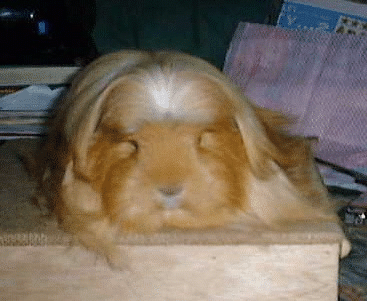Coronets became recognized February 1, 1998. They are one of the two new breeds that have recently become recognized. Coronets have the fur of a Silkie, having long sweeps and no part. But they also have a crest on their head, like the White Crested. Please look below at a picture of a Coronet, if you're not sure what they look like. Coronets are recognized in all of the groups and varieties.
In the United States, around the late '70's and early '80's Coronets originated from several sources among which were the Pankratz stock (California) developed from pet quality crested Americans with longer rump hair bred to top quality silkies; and Jennifer Lin's stock (Washington). Canadian fanciers also worked to develop this unique breed about the same time.
Never being accepted past thier first showing, Coronets are still a working breed and due to again come before the ARBA Standards Committee at the ARBA National Convention in 1994.
What is so unique about the Coronet? Coronets reproduce Coronets when bred to each other, a requirement of being considered a true breed. They also reproduce Coronets (most of the time) when bred to Silkies. They resemble in some ways Silkies, in other ways Crested Americans, but are different from both of these breeds. They have appeal to many with their floppy head furnishings hanging down their short faces and their manes flowing into the rear sweeps. The babies are absolutely charming, in my opinion!
Now, what makes a good Coronet Cavy? Aim for exquisite texture and voluminous density; short, broad Roman nose with large, bold eyes and slightly drooping ears; uniform side and rear sweeps over a cobby body; and a glorious coronet that elongates the as the cavy gets older, full in appearance and gracefully blending at the back into the rear sweep, with the front of the coronet drooping over the face. The reason I prefer the "loose coronet" that hangs down over the eyes is because in my experience, if the cheek sweeps and side sweeps are to develop length to balance out the rear sweep, the crest will lengthen also. A tight crest is very attractive but I have not come up with one that also produces good length on the sides. (If you have, I would like to get some of your stock!) At any rate, the crest or coronet should radiate evenly from a clearly defined pinpoint center and retain a full, even appearance as it develops. No trimming!
The English standard gives the crest 20 points out of 100 and describes the "coronet" (crest) to be "Neat, even, and symmetrical, in keeping with head shape, adorning the head to give a balanced appearance." Also in the English standard the Coronet Cavy is to be presented and condition are 20 points. The balance of the points is on the coat, (35), head (15) and bosy (10)
The proposed working standard for the Coronet under ARBA's Standard is the following:
General apperance and presentation.....5
Type..................................10
Head...................................5
Coat..................................50
Density, Texture, Mane, Side Sweeps, Rear Sweeps 10 points each
Coronet (crest).......................15
Condition.............................10
Color..................................5
Total.........................................100
The Coronet Cavy is presented without a part in the coat, similar to the presentation of the Silkie, and judged similarily, with the coronet or crest receiving enough points to give it the importance it merits. Balance overall us ti be achieved; all parts come together in a harmonious picture, complimenting each other.
A junior or intermediate Coronet may have a more open crest which will usually fill in by the time it becomes a senior. Also the nose hair grows upward, interfering with the crest's downward growth, resulting in a splitting of the crest on the bottom portion. This also will correct with lengthening of the crest. The longer hair of the crest may cause it to flatten because of the weight, but the crest should at all times retain a full and even appearance and not to be ragged.
General eliminations and disqualifications apply to the Coronet, with added faults of doubling, guttering or open center and off-center coronet. Specific disqualifications: rosettes or parial rosettes in the coat other than the coronet, hair reversal on the feet.
Coronets in full coat are indeed a lovely sight to behold!

This picture was submitted to me by Christine Fort at chris@fort.freeserve.co.uk. The piggy in the picture is named Bella. Thank you so much for your photo of your beautiful cavy!
If anyone has any additional information (or photos) on Coronets, then please e-mail me at cavykingdom@angelfire.com. You will get full credit for any info you give me!!
My Links
Click here to go to my home page
Click here to return to Breeds